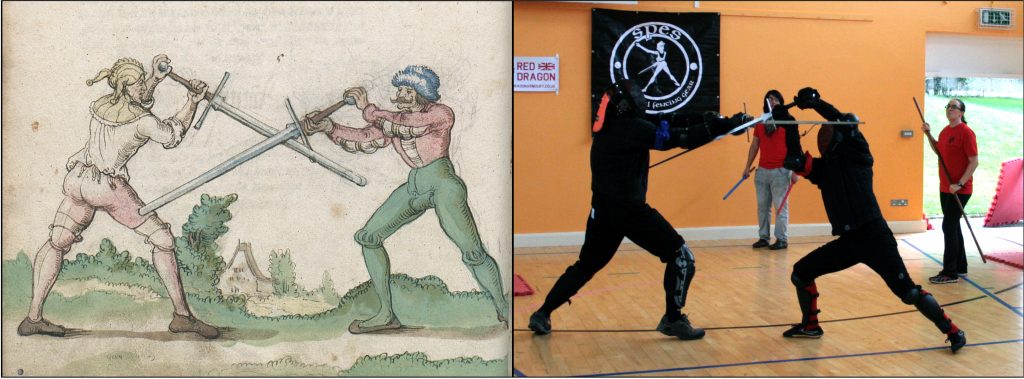Rather than an interview this time around, we have some thoughts on applying new techniques in sparring from Matthew Malcolm, head instructor up at Medieval Combat Group in Belfast. For those who don’t know Matt, he’s been training in Early Liechtenauer longsword for around six years now, competed in SWASH and Fightcamp back in 2012/2013, taught at the inaugural Féile na Gaiscígh, and took League Champion in the 2016 Irish Historical Fencing League. His main interest and focus within HEMA is technical interpretation and application.
Without further preamble, over to Matt:
This is far from a definitive discussion, or some guidance from an ancient philosophical master, but it is a short discussion piece on some of the issues that I have faced with my sparring, and how I have guided my technical improvement. Hopefully you’ll find some of the issues familiar and the discussion will be of help.
Not covered in this article is escalation of intent; with exercises progressing from a slow drill environment to a high intensity tournament setting (an article in and of itself); due to this being about a specific single aspect.
What is technical sparring?
Technical sparring to me means using the right technique at the right time, with good form. You don’t just do a technique; you apply a technique to a specific set of circumstances and you need to get to the point where you can consciously, or sub-consciously, apply a technique at the right time. The only way to do this is to practice it, then practice is some more. It is advisable to practice slow, building up to sparring speed, introducing choices for each person in the drill, and so on, but that is a broader subject than this article will cover.

Feeling like a beginner?
So you’re a beginner, you’ve been practicing for a few months and you love sparring. It’s a rush, you get all hyped up and excited but as soon as you go start fencing it’s all a blur. This may sound familiar, and certainly this was the same for me. However when you do this you forget what you’ve learnt and you can’t make any techniques work!
There’s a long term expectation that you will eventually get used to sparring, and it will appear to ‘slow down’. You won’t get the same adrenaline rush, but you will be able to think much more clearly, and this will not only allow you to be in much better control of the engagement but you will also find it easier to think consciously about technique.
Preparation, preparation, preparation
As in all things, preparation is the key. You need to acknowledge that when you start to spar all but the most deep-set and fundamental conscious thought goes out the window. So you need to prepare what you are going to do so you can stay focussed and remind yourself of your aim. Set yourself a goal for your sparring session; and I don’t mean, ”Today I’m going to win more”. That’s not helpful.
Before you come to fencing pick a technique you know and some key points; you will need to have learned enough about it to use it; chat to your instructor about this if you’re fuzzy on any aspects or need a quick recap. If you want to improve technically this preparation stage is crucial. Think about the following points and be familiar with at least some of these:
- The basic form of the technique; body mechanics, blade mechanics etc.
- The stimulus for the technique: what you should use it against, the position of the opposing blade and fencer, their intentions.
- The concept of the technique and what it aims to do.
- The timing of the technique; exactly when to apply it to the stimulus.
- The execution of the technique; how much pressure, the precise blade placement, and the control of the opposing blade.
- Lastly, the precise structure and form of the technique; like point 1 but honed.
You don’t need to know all of these, as some of these will only be learnt through practice, but you need to at least know the basic form and the stimulus. The rest can follow as you improve. I’ll talk you through my interpretation of one technique to give you an idea of how I approach this; let’s take the Schielhau.
Practical Example
Firstly I practice the cut lots so that I am consciously and subconsciously aware of the cut; this is my basic form (point 1). You can either learn this in class with your instructor or read the sources.
Next I look at the applications: against an oberhau, against plough, against a thrust; and now I pick one. So let’s take against an oberhau.
I think about when I am going to apply it: when someone lifts up into Vom Tag to strike from their right shoulder I will strike the shielhau and try to strike them on the head; this is the stimulus for the technique (point 2).
Now in the days leading up to fencing I visualise the strike; before I go to sleep, when I am commuting to work, day dreaming etc. I think about what position the opposing fencer is likely to be in, how they will strike, what angle they will strike and how I am going to respond. I also think about what I am to achieve with this technique; the concept (point 3). I aim to close the upper left line of the oncoming cut, be in blade contact with their blade while I strike them on the head.
During fencing I exercise discipline in sparring; I don’t spar to try and win, I spar because it’s an excellent ‘live’ setting to train techniques. In each sparring bout I forego all other openings in favour of practicing this one technique. I keep distance from my opponent, parrying if needed to stay safe, but wait for the correct position to apply this technique. In this way through my successes and failures I will learn timing and execution (3&5) of the technique; varying the timing, blade placement, footwork etc. with each attempt to find an optimal use. I am not concerned about failure; rather a failure gives me important information to calibrate my next attempt.
As I practice I cement the stimulus and execution of this technique in my mind and make it more likely for me to remember in subsequent sparring sessions.
The structure and form of the technique comes through time as my body learns what position is optimal for this technique and I execute it many, many times. This is refined and informed by non-sparring drills between sparring sessions. It still isn’t perfect; but it is much more useful now that it has been practiced at length.

Scientific Method
This process may seem complex, but this is basically how to conduct an experiment. Plan what you want to test, test it in the environment you intend to use it, change elements of the execution (variables such as angle, power, timing, distance etc.) to measure its success in response to the same stimulus, use the information you receive to inform subsequent tests of execution, and amend the execution to yield a better outcome. It’s important to keep an open mind; just because someone you respect says something is a particular way doesn’t mean that they are right, or that it will not work differently for you.
The frustration of technical fencing
Technical fencing is hard. It takes a while to get it to a useable standard; and you’re going to have a tough time applying it both to beginners and to experienced fencers, especially in the high speed high pressure environment of sparring.
- Under the pressure of sparring, a lot of beginners just randomly roll dice in their head; improvising their response in a non-structured and erratic fashion. They won’t realise the threat you supply to them and do something that is ‘stupid’; resulting in doubles.
- An experienced fencer will quickly see you try to apply a technique they know, maybe they know the counter too, and will at least know how to avoid it.
Both of these circumstances mean there is a clear intermediate plateau; where it just feels like you’re getting worse. You don’t get the same number of hits on beginners because you are now aware of the threats they pose and are more reluctant to attack, and you don’t get hits on people better than you because they can read you too easily. The way to overcome this is to give yourself time and continue to train consistently. The more you plan your individual techniques in isolation the better they will become.
You are only as good as your training partner
Get a good training partner, with consistent technique, who shares your desire for technical improvement. You will have another eye to cast over your technique, that you can bounce ideas off, and so you can inform them exactly what stimulus to give to you. Consistency of stimulus will mean your experiment suffers from less variation outside of your control; allowing you to focus strictly on your execution. This is a reason that training with your instructor is a much more valuable experience; but they will always be short on time.
Conclusion
Even though you go to classes and get tuition your improvement is up to you. Plan areas that you want to work on, and talk to your instructor about these and get their input. Instructors should be interested in the development of their students and should try to give useful assistance. For example this article is written in response to a conversation with a student; I realised I hadn’t documented my method for improving my technical ability.
The most valuable things in life are not free, and the price you pay for this improvement is time and effort; but it is ultimately worth it if you want to improve your fencing. The same methodology can be applied to competitive fencing techniques; or rather than using a new technique, to improving an existing one.
I hope this was an interesting insight into how I approach this aspect of technical improvement and feel free to ask for any clarification.
